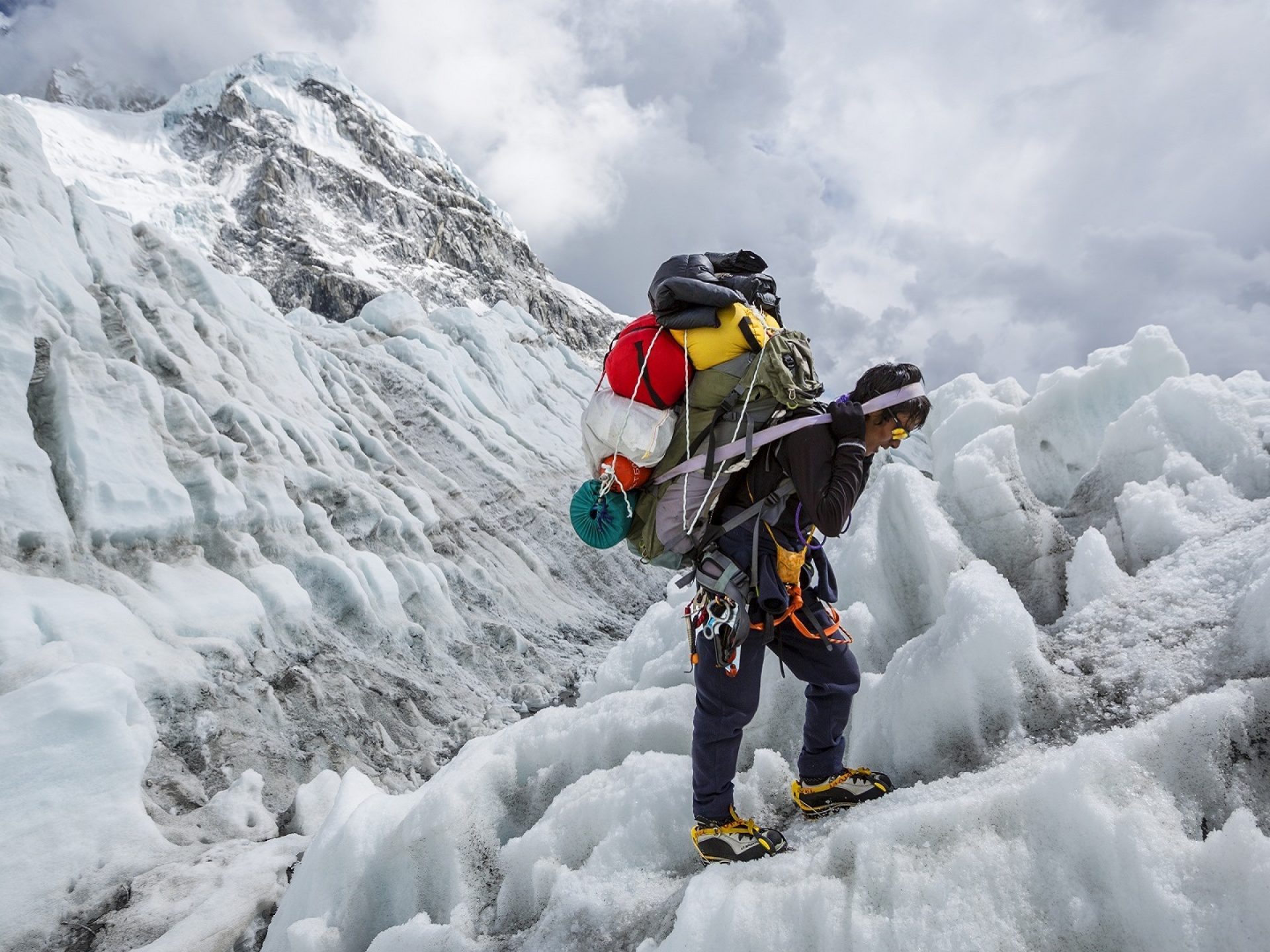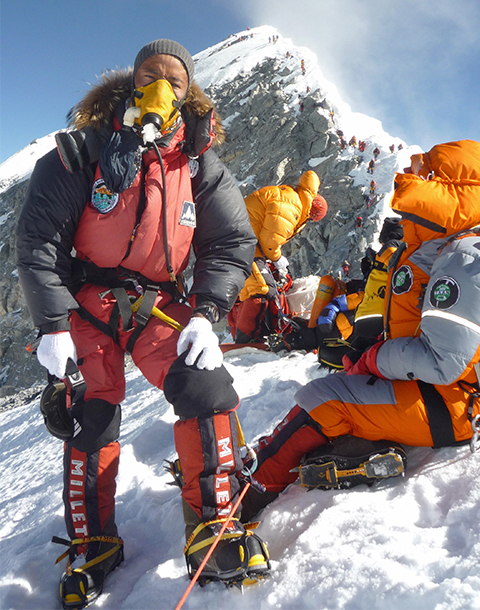Magazine

October 23, 2019

This article was originally published in Populous Magazine, our biannual publication featuring news, information, and trends from the worlds of sport, entertainment, and major public events. Find out more, and sign up to receive a free copy, here.
Every year, Sherpa climbing guides help hundreds of mountaineers up Everest. And most years Sherpas are among those who die in the process. Dominic Bliss salutes these unsung heroes.
No one knows for certain how many dead bodies lie on the slopes of Mount Everest, buried in the ice and the snow. In all, over 300 mountaineers have died attempting to reach the summit, the majority of them Nepalese porters and climbing Sherpas. Because of the harsh conditions, their bodies are often left unrecovered where they fall.
Two of the worst years ever for fatalities were 2014, when 16 Sherpas died on the Khumbu Icefall, and 2015 when a massive avalanche engulfed the South Base Camp, killing at least 20, mostly Sherpas.

So popular is Everest that the final approach to the summit often gets congested
Working as a Sherpa, or climbing guide, on Everest is one of the riskiest jobs in any sport. As well as avalanches and falls while climbing, one must run a sniper’s alley of falling ice, collapsing crevasses, altitude sickness, exposure, frostbite, retinal haemorrhages, blizzards and winds powerful enough to blow you off the mountain. The riskiest place of all is above an altitude of 8,000 metres – the so-called death zone – where oxygen levels and atmospheric pressure are too low to sustain human life for any length of time. The summit of Everest is at 8,848 metres, making the death zone unavoidable for glory-seeking mountaineers.
One professional Sherpa who has met more than his fair share of glory-seekers is Da Gelje Sherpa – or Dawa, for short – a guide with a Kathmandu-based expedition company called ExpeditionHimalaya.com. (Confusingly, Sherpa is both the name for a climbing guide and the ethnic group from which most of them hail.) A 55-year old father of five, originally from the Solukhumbu District (the area in which Everest stands),nowadays Dawa spends most of his working life at Base Camp. But in his younger days he summited Everest a total of seven times, most recently in 2007.
A year before that, he remembers the death of a climber just below the summit. Dawa had successfully led his own group to the top and was asked to help with a Russian climber from another group who was suffering badly from the altitude. “Fifty metres below the summit he had serious problems. He went crazy with altitude,” Dawa tells Populous magazine. “I helped bring him down more than 100 metres. But after that he died.”
As well as avalanches and falls while climbing, one must run a sniper’s alley of falling ice, collapsing crevasses, altitude sickness, exposure, frostbite, retinal haemorrhages, blizzards and winds powerful enough to blow you off the mountain.
Every year, it seems, Everest is the scene of some horror story or another. If it’s not avalanches or falls from the mountain, it’s brawls between rival Sherpas, or overcrowding on the slopes. Over the years Everest has been climbed well over 8,000 times. Add to this the extreme weather which makes the window of opportunity for summiting very small; some years, just a few weeks during May. No wonder there have been reports of congestion so thick that climbers are sometimes forced to pick a path through the corpses of their fallen colleagues.
The greatest problem of all, Dawa says, is that too many foreign mountaineers lack sufficient experience and training. “They only think about the summit,” he complains. “They don’t understand safety. They get to 8,000m and they think, ‘It’s only 800m left to the summit.’ They think it’s easy. But Everest is never easy. It is very, very dangerous.” He says some mountaineers become so obsessed by glory that they ignore the safety warnings of their Sherpas and press on to the summit without them.
As well as carrying oxygen bottles, water and food, Sherpa duties include navigation, setting up camp, managing porters, plus of course all the highly technical climbing skills. “A job that can encompass not just the duties of a guide and porter, but also those of a butler, a motivational coach, and a lifeguard,” explains Chip Brown, a writer with National Geographic magazine.
The tribal name Sherpa means ‘people of the east’, since they originally hail from eastern Nepal. They are just one of well over 100 different ethnic groups across the country. The assumption is that years of living at high altitude has allowed their bodies to adapt genetically to lower oxygen and a thinner atmosphere. Indeed, when they come down to sea level they suffer just as sea-level dwellers suffer at altitude. “I feel tired and lazy down here,” Dawa said on a recent visit to London. “When I go back to the mountains I feel better; more energy.”
In the old days, mountain guiding used to be a Sherpa’s golden ticket out of poverty. Modern times have brought opportunities to move to lower altitudes and work in other fields. However, for the most skilled climbing Sherpas, guiding can still be a very lucrative business, earning them up to US$8,000 over the short season, according to BBC Nepali.
One of the most successful Sherpas of all time is 49-year-old Kami Rita Sherpa who has summited Everest a record 24 times, including twice in May 2019. Brought up in the same Solukhumbu village as Tenzing Norgay, the man who accompanied Sir Edmund Hillary on the first successful ascent of Everest back in 1953,Kami Rita comes from a family of climbing Sherpas. He first climbed Everest in 1994 and has stood at the top of the world almost every year since. One of his uncles died in the 2014 Khumbu Icefall, and Kami Rita was there to help dig out the bodies. He was also on the mountain to witness the 2015 avalanche at Base Camp.
Having seen so much death and destruction, he is keen to point out how he and his colleagues deserve more recognition for their hard work. “The Sherpas make their way, fixing the ropes,and the foreigners give interviews saying Everest is easier. Or they talk about their courage,” he told the BBC in a recent interview. “But they forget the contribution of the Sherpa. Sherpas have struggled a lot to make it happen. We suffer.”
As well as avalanches and falls while climbing, one must run a sniper’s alley of falling ice, collapsing crevasses, altitude sickness, exposure, frostbite, retinal haemorrhages, blizzards and winds powerful enough to blow you off the mountain.
Back at ExpeditionHimalaya.com, Dawa is optimistic that the recent disasters will usher in more stringent safety regulations. The Nepalese government has already helped with insurance. He suggests that tourists should have to submit to stringent tests before being granted climbing permits, and that the prices for these permits should be raised. To relieve congestion on Everest, he would also like to see a one-way system on the busier sections – with one roped route just for ascending climbers and another just for descending climbers.
Ironically, death on Everest doesn’t seem to deter the mountaineers. The opposite, in fact: the more climbers perish, the more the mystique of this great mountain grows.
Alan Arnette is a veteran US mountaineer who reached the top of Everest in 2011. He notes how a year of multiple fatalities often results in a greater number of climbers the following year. “Bad news only increases the allure of climbing Everest,” he says. “Like bugs to a bright light.”
Lorem ipsum dolor sit amet consectetur, adipisicing elit. Non facere corporis et expedita sit nam amet aut necessitatibus at dolore enim quis impedit eius libero, harum tempore laboriosam dolor cumque.
Lorem, ipsum dolor sit amet consectetur adipisicing elit. Illo temporibus vero veritatis eveniet, placeat dolorem sunt at provident tenetur omnis, dicta exercitationem. Expedita quod aspernatur molestias eum? Totam, incidunt quos.